A Season in Time: LSU Tigers 1908
References: The Fighting Tigers II, Peter Finney (1980)
The Louisiana Tigers: LSU Football, Dan Hardesty (1975)
This series of articles chronicles LSU's first undefeated season of more than three games.
The campaign would involve a heated eligibility challenge.
College football in 1908 was considerably different from the game we watch today.
- The field was 110y in length.
- Kickoffs were from midfield.
- The offensive team had only three downs to gain 10y.
- Touchdowns were worth five points. The team that scored a touchdown had the option to kickoff or receive.
- Field goals earned four points. The goal posts were on the goal line.
- Any player removed could not return to the game. As a result, teams usually consisted of fewer than 20 players, sometimes as few as 12 or 13.
- Of the eleven players on the offensive side, at most five could be in the backfield at the snap of the ball.
- Interior linemen often took handoffs and ran with the ball.
- Four officials worked each game: referee, umpire, field judge, and linesman.
Forward passing was legal but with restrictions.
- First of all, the football itself was much rounder and harder to throw than today's spheroid: 27" circumference around the middle compared to 21.5" today.
- The ball had to cross the line of scrimmage within 5y of where the ball was snapped with the team violating this rule losing possession. To help officials determine the 5y laterally, lines were painted on the field parallel to the sidelines. This led to the term "gridiron."
- A pass tipped by either team and caught by an offensive player resulted in the defense gaining possession at the spot of the illegal touching.
- An incomplete pass could be recovered by any member of the defensive team or by the first player (if there was one) on the passing team who touched the ball.
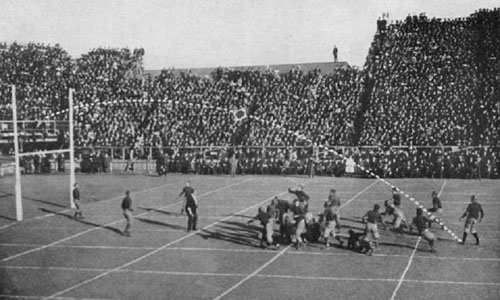
1908 football game on the "gridiron" at Harvard
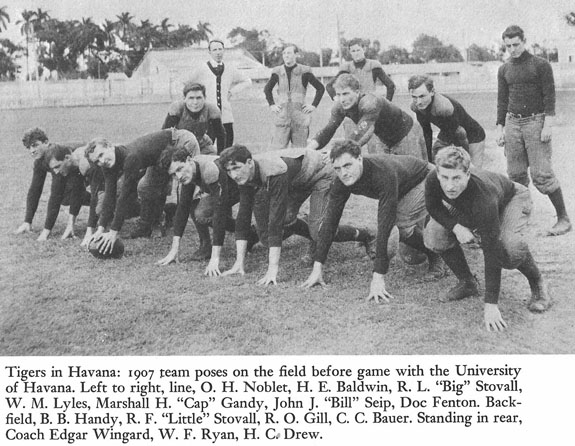
The earliest reference to LSU's '08 football season came in the Baton Rouge Daily State on January 8.
- Since only one player graduated from the '07 team that went 7-3 as a member of the Southern Intercollegiate Athletic Association, prospects looked rosy for the next season.
- Never before in the history of football [since 1893 at LSU] were the prospects for a season as bright as next year's outlook ...
- The most anticipated change was the move of "Doc" Fenton to quarterback.
|

Doc Fenton
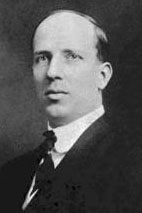
Edgar Wingard
|
They called George Ellwood Fenton "Doc" because his dad sang with traveling Indian medicine shows.
- He was born in Scranton PA in 1887 but began his college athletic career in Canada in 1904 at St. Michael's College where he played rugby (which was much closer to American football then than it is today). Doc later said, I got all the fundamentals of playing rugby in Toronto. I learned how to kick on the run, and I learned how to operate in the open field.
- He then played football at Mansfield State Normal School back in his home state. He became the star receiver in 1906, the first year of the legal forward pass.
- The first Southern university to contact Fenton was Mississippi A&M (now Mississippi State). Fred Furman, the brother of a teammate, had been hired as the football coach and tried to enlist his brother and three others, including Doc, to go with him to Starkville.
- One day a well-dressed man introduced himself to Fenton after practice. My name is Edgar Wingard. I'm the new coach at Louisiana University. How would you like to go to a Southern school? A native of the Keystone State himself, Wingard had coached the Pittsburgh football team in '06.
- His first impression of the visitor being favorable, Doc promised to consider LSU. Edgar followed up with regular letters to Fenton. Then one day in the spring of '07, Doc arrived home to find an unknown woman speaking to his mother. She turned out to be Mrs. Wingard. As a speaker, said Doc, his wife was just as impressive as he was. She sure impressed my mother. Before she left, I promised to go down to Baton Rouge for a visit.
- So that summer, Doc headed south with another Pennsylvanian, E John Seip, whom Wingard also wanted. Fenton later recalled: Baton Rouge was a nice little town, but I have to be honest and say the thing that really sold me was the nickel beers. We had blue laws back home and Wingard was quick to point out they had blue laws in Starkville too.
- Later, when Furman tried to prove that Fenton was illegally recruited, Doc produced the letters the new A&M coach had written to him, letters that contained some mighty interesting offers. So the schools agreed to drop the issue. The Tigers beat the Maroons 23-11 when they met that fall in the Capital City.
- If he had stayed in the Northeast, Fenton would have set the football world on fire. But displaying his talents in the Deep South, he didn't make Walter Camp's All-American teams. which included seven HBs, in either '07 or '08.
- Future LSU president Troy Middleton: I saw Jim Thorpe, but Doc Fenton was better.
Marshall Gandy: Doc could do more with a football than a monkey can with a coconut. He was the greatest field general who ever donned a uniform, a fellow who could punt on the run and catch the football one-handed. Doc was the hub of our team and we were the spokes.
Wingard returned to Baton Rouge September 14 to get his team ready for the '08 season.
- All the players arrived by that date for the start of the school year. They got settled on the campus, which was located a few blocks off the Mississippi River near the capitol. Enrollment exceeded 550 and continued upward into October.
- Wingard wasted no time in getting his charges onto the practice field on the 15th. He had brought many innovations with him from Pennsylvania. Preferring a wide-open game, he developed agility at his practices. For example, he had the players engage in soccer matches to improve their footwork. Joe Prichard from Vanderbilt assisted the head coach with the team.
- Three solid gridders who hadn't played the year before joined the '07 veterans.
The Smith brothers from Michigan who had been recruited by the previous coach in '05 and played for one year (24-year-old Bob) or two (27-year-old Clarence) before dropping out and going to work. Edgar talked them into returning to school.
Mike Lally from Pennsylvania would play the opposite halfback beside Fenton. A fine runner in his own right, he would also block efficiently for Doc.
- Other newcomers, some of whom would be called "walk-ons" today, joined the team until Edgar had three full elevens for practice. Numerous students and townspeople, excited about the new season, attended the practices and were impressed by the depth of talent.
- The first scrimmage took place on Saturday, September 26. The "Varsity" defeated the "Scrubs" 5-4. Lally kicked a field goal for the Scrubs in the first half while Clarence Smith tallied a touchdown in the second for the victory. Fenton played right end, the same position he held down in '07. He made a game-saving tackle when Prichard of the Scrubs picked up a fumble and ran 25y to the three where Doc coralled them. The regulars held and took over on downs.
- The State-Times reporter thought that to pick out this year's team the coach will have one of the hardest jobs of his career.
- The scrimmage doubled as a fund-raiser. Expecting a top-notch team, Wingard wanted to clothe them in A-one gear. So spectators paid 25 cents to watch the scrimmage, with the fee going toward new uniforms. Fund raising continued on campus until the needed amount was achieved.
- Fenton played right end again in the September 29 scrimmage, which the Varsity won 22-0 in two ten-minute halves. Bob Smith missed the scrimmage with a severely sprained ankle and was expected to be out at least another week.
LSU would finally get the chance to play another team on October 3 when they hosted the Young Men's Gymnastics Club team from New Orleans.
Continued below ...
|
This series of articles chronicles LSU's first undefeated season of more than three games.
The campaign would involve a heated eligibility challenge.
The Tigers opened their season with a hastily arranged contest against the Young Men's Gymnastic Club (YMGC) of New Orleans (the forerunner of the New Orleans Athletic Club).
- Practice intensity picked up as October 3 approached. After the workout two days before the game, Reuben Gill told the State-Times: Great improvement in the line. Captain Gandy agreed: More improvement shown today than ever before. However, Bob Smith remained on crutches and was doubtful for the opener.
- Aided by the big Yankees that Coach Wingard had recruited, LSU would outweigh YMGC by about 15 pounds per man (175-160). But it was hard to imagine they could match the Tigers' speed.
- YMGC was coached by Frank "Tad" Gormley, a native of Cambridge MA who had moved to New Orleans in 1907 to run the club.
Gormley coached the LSU basketball team from
1921-23 and assisted with football. Since he was a major figure in track and field in Louisiana, City Park Stadium in New Orleans was renamed for him after his death in 1965.
LSU Lineup for 1908 Opener
| Pos.
| Player
| Hometown
| Ltrs
|
| RE
| Doc Fenton
| Scranton PA
| 1
|
| RT |
Oren Noblett |
Denham Springs LA |
3 |
| RG |
Willie Hillman |
Minden LA |
2 |
| C |
Robert Stovall |
Dodson LA |
2 |
| LG |
Bill Pollock |
Bernice LA |
0 |
| LT |
Marshall Gandy (C) |
Negreet LA |
2 |
| LE |
John Seip |
Allentown PA |
1 |
| QB |
Reuben Gill |
Ruston LA |
1 |
| LH |
Rowson Stovall |
Dodson LA |
1 |
| RH |
Clarence Smith |
Albion MI |
2 |
| FB |
Michael Lally |
Jessup PA |
0 |
| Substitutes |
| RG |
Sentill |
|
0 |
| LG |
Arthur Thomas |
Baton Rouge LA |
0 |
| LE |
O'Bannon |
|
0 |
| QB |
Jonnie Albright |
Memphis TN |
0 |
| LH |
Pat Ryan |
New Orleans LA |
0 |
| RH |
Harvey |
|
0 |
In today's parlance, the game would be called a "Rent-a-Win" as LSU romped 41-0. The detailed account of the game in the Times-Picayune gives a good taste of what 1908 football was like, with emphasis on the FOOT.
- A fair crowd, consisting largely of the students of the University, who were present with the cheerleaders witnessed the contest. (The cheerleaders were male although LSU had admitted a handful of female students starting in 1906.)
- LSU wins the toss and elects to kick off, Fenton booting to the three. Clarence Smith recovers a fumble on the first possession at the 10, and the Tigers waste no time in turning the break into points. Lally gains four after which Smith fittingly goes the rest of the way. Fenton kicks the goal to make it 6-0. Only 1:33 has elapsed.
- A 15y penalty for sideline coaching against LSU puts the Gymnasts in fine position within six yards of Louisiana's line. But after two plays gain only one, Robert Stovall pounces on a bobble at the nine. Fenton gains eight on an end-around, then kicks 50y down the field (probably on the run). After gaining only three, the visitors punt back but only for 25y. After a 5y markoff for offsides, Doc booms a 60-yarder. That sets up a safety when Hale's punt goes straight up (blocked?). 8-0 LSU
- After YMGC kicks 40y, John Seip returns the ball 15y. LSU gains 20 on a "side pass." Gill goes for five before Fenton kicks a field goal to make it 12-0. That completes the 15-minute first half.
- YMGC kicks off to Doc, who returns it 70y. Wingard has a new quarterback in the game, Jonnie Albright, who goes for seven. T "Baby" Noblett, all 235 lb of him, gains eight for the touchdown. Fenton again kicks the point to make it 18-0.
- Since the scoring team had the option to kick or receive, YMGC kicks off again, Fenton being coralled after only 20y this time. He then boots 65y to put the opponent deep in their own territory. After netting -2 on two plays, the New Orleanians punt 30y to Albright who brings it back to the original line of scrimmage. Doc gains 11 on another end around. 195 lb captain and LT Marshall "Cap" Gandy makes four, then Lally covers the remaining three. Another PAT by Doc makes it 24-0 with 5:10 elapsed.
- Again, YMGC kicks off, Albright returning 10. Fenton gains five, and Seip takes in a pass for 15. Harvey adds 15 before Seip gets 25 to put the ball on the 10. T Gandy goes over from there. Mr. Automatic makes it 30-0.
- It's hard to catch up when you have to kick off every time the opponent scores, but that's what the rules called for. On the first play, Fenton kicks 40y, but an offside penalty nullifies the boot. Harvey gallops 25 around right end before another newcomer, Pat Ryan, gains 10. Then it's Seip for 15, Fenton for 20, Harvey for eight, and Ryan the final five for the touchdown. Fenton makes it 36-0.
- YMGC kicks off to Fenton who runs 15y, then boots on the run for 55y. But the visitors don't want the ball deep in their territory; so they kick back to Lally who returns the pigskin to the 10. Gandy gets his second touchdown of the day from there. This time, the try is missed to keep it 41-0.
- With even more substitutes in the game, LSU takes the next kickoff and begins to move: Lally for 10, Ryan 30, O'Bannon four. But a fumble turns the ball over, and shortly afterwards time runs out with the ball on the LSU 30.
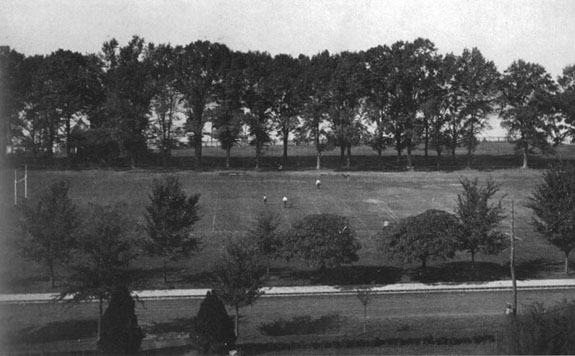
Athletic field on the downtown LSU campus with the Mississippi River in the background. Next came another breather that was hardly worth the trouble except to give the most important player practice at a new position.
- The opponent was the army team from Jackson Barracks in New Orleans, which had been practicing for several weeks.
- This game was arranged hastily after Ole Miss cancelled their game set for October 14 in Baton Rouge. The Oxford faculty wouldn't approve the game because it was set too close to another game.
- Wingard planned to hold Seip, Pollock, and "Big" Stovall (Robert) out of action to let them heal their injuries. Willie Hillman would move to center with Tommy Thomas taking the vacated guard position. "Little" Stovall would take his brother's place at left end with Bob Smith returning to action at the left half position.
- The big news, though, was that Fenton would switch to quarterback, a move that had been promised as early as January. Gill swapped places with Doc, lining up at right end.
As in the YMGC game, LSU totally outclassed the opponent before a Sunday afternoon crowd of about 1,000.
- Fenton runs the kickoff back to the 25. On the first play from scrimmage, he boots to the opponent 25, a 55y punt. After two runs go nowhere, the Soldiers punt to Fenton who advances to the midfield stripe. "Little" Stovall runs around right end for 10, then Smith for 10 off tackle. Fenton keeps for 20 more. Lally navigates the final 15 for the first touchdown only 1:30 into the game. Doc misses his first extra point of the young season.
- The rest of the first 20-minute half goes the same, the Tigers adding five more touchdowns.
Gandy breaks off a beautiful 40y run to pay dirt, and this time Fenton kicks the goal to make it 11-0.
With Army backed up at its five, Hayes tries to punt from behind his goal line, but the kick is blocked. Hillman falls on it behind the goal line. (The term "end zone" was not in use yet.) 16-0
Lally, Smith, and Stovall carry once each to move the ball within 20y of the goal. Fenton then placekicks a field goal almost as practice for when it may be needed. 20-0
Gill takes his turn at scoring. 25-0
Fenton scores the final touchdown of the half and kicks goal. 31-0
The half ends with the Tigers in possession at the Army 35.
- The second half brings more of the same.
Clarence Smith gets into the scoring column with a 25y run. Fenton converts. 37-0
Stovall scores the next touchdown. 42-0
Lally makes a sensational 60y run and kicks the goal himself. 48-0
Then comes a stunning play that allows the Soldiers to avoid a shutout. With LSU in position to score again on the 5, Ryan lets the ball slip, and Army right half Culligan grabs it and, with a 5y head start on the field, holds his lead for the entire 105y. Hall fails to convert, and the score remains 48-5. The touchdown would be the only one scored on the Tigers all season.
Ryan, taking Smith's place at right half, tallies the next touchdown and kicks the goal. 54-5
Lally scores again. 60-5
Lally laterals the ball to Stovall who touches it down behind the goal. 65-5
LSU gives Big Baby Noblett a chance to score the next touchdown. 70-5
Lally makes his third touchdown. 75-5
Smith tallies the final five-pointer, and Hillman takes a turn at booting the point. 81-5
- The State-Times writer was impressed with newcomer Lally.
In Lally and Fenton the University has a pair that can hardly be equaled. In the game Fenton showed that he has lost none of his ability to dodge, his swiftness as a runner, his power as a punter and kicker, and his cool hard work. ... The two work splendidly together. Lally's interference is superior to Fenton's, and he is just as swift on his feet. He knows the point that he is making for and takes the shortest line for it, while Fenton will dart in and about like a rabbit. His punting and kicking in the game showed that he was also the equal of Fenton in this work. ...
The team work ... shows considerable improvement over the last game a week ago. The forward pass was worked successfully a number of times, but most of the L.S.U. gains were made by the end runs.
After two cream puff opponents, LSU now prepared for their first stern test - the Texas Aggies.
Continued below ...
|
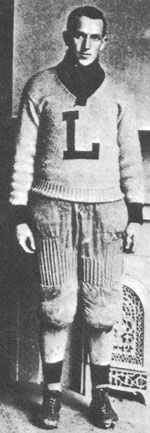
Clarence Smith
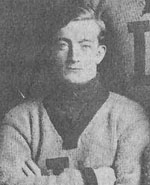
Mike Lally
|
The Tigers prepared for their first test of the '08 season - "A&M of Texas" at Pelican Park in New Orleans on Saturday, October 17.
The Crescent City alumni of the Old War Skule relished their first opportunity to see their alma mater in action since 1905 when the Tigers played at Tulane.
- Team Manager R. L. Himes ("manager" in those days meaning "business manager") explained during a visit why the game was being played in the state's largest city.
We have been appealed to for several years to schedule some of our games down here, and the alumni assured us that if we did so the games would be liberally supported. We will run an excursion [train] down from Baton Rouge, giving all students of the university and the people of Baton Rouge ample opportunity to see the game. The same thing will be done when we play the Haskell Indians at a later date.
- A committee of grads met in the office of Warren Easton, superintendant of the public schools, to arrange the details of the day, including the reception and entertainment of both teams.
- They expected a crowd of 5,000-6,000 for the contest against the Aggies.
- Even Tulane enthusiasts, who "love L.S.U. little," planned to set aside any ill feelings and support their Louisiana rival against an out-of-state foe. Although the Tigers and Green Wave weren't scheduled to meet in '08 because of enmity between the schools, Tulane coaches and players would attend to see what tricks the Tigers would pull out of their sleeves.
- Some New Orleans LSU alumni promised to reciprocate at a Tulane game, distributing 150 copies of the Green Wave songs and yells, including the distinctive "Hullabaloo, hurrah-hurrah" cheer.
Football fever had definitely infected the LSU campus. The Baton Rouge Daily State-Times the day before the game:
Ask any student at the University what he is thinking about and he will say, "About the trip to New Orleans tomorrow." Ask the topic of conversation among the congregated groups of students and the answer will be: "The trip to New Orleans." This is the all-absorbing question under discussion here. Every student is aglow so enthusiastic is he about the trip.
Eight railroad coaches would transport 800 passengers – including the LSU team – from Baton Rouge at 7:30 AM Saturday morning.
- The LSU-A&M clash would start about 4 PM following the conclusion of the 2 PM contest between Baton Rouge High and Boys High of New Orleans (later renamed Warren Easton). Cost for the doubleheader was $1 for adults and 50 cents for children under 14.
- Newly-opened Pelican Park, home of the New Orleans Pelicans minor league baseball team, was located across Carrollton Avenue from what is now Jesuit High School (which was situated on Baronne Street in 1908).
The Tiger team had to stick to their knitting amid all the hubbub.
- All the special formations and plays were in place. The last practice before the trip to the Crescent City emphasized running signals, punting, drop kicking, block kick ... The work was fast, the movements successful and the word hard.
- Coach Wingard said the team did good work, and Captain Gandy and star QB Fenton agreed.
- "Big" Stovall would miss the game because of a bum knee. E Bill Seip was out of the hospital and on the practice field vowing to play Saturday, but his teammates said they wouldn't allow him because he was unfit.
- The Aggies brought a 1-1 record to Louisiana having defeated Trinity 6-0 and lost to Baylor 6-5 (the equivalent of 7-6 today). The team was under the charge of its third coach in three years, N. A. Merriam.
- LSU sought revenge after losing 11-5 in College Station in '07.
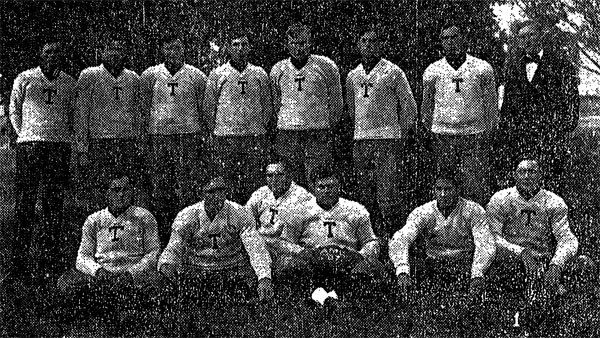
1908 Texas Aggies with Coach Merriam
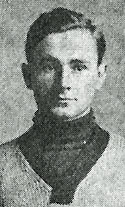
Reuben Gill
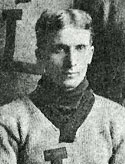
R. F. Stovall
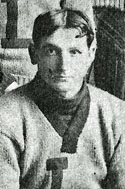
Marshall Gandy
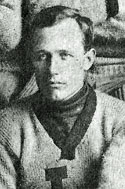
Willie Hillman
|
Showers that fell at intervals during the afternoon didn't dampen the spirits of the 1,500 fans.
First Half
- A&M received Fenton's kickoff but punted after gaining only 1y on two tries. After an offsides penalty on its first offensive snap, the Tigers kicked back to the 20, Charles DeWare returning it 5y. After a 15y penalty for an illegal forward pass (probably because the passer was more than 5y laterally away from the center), the Aggies threw another that the receiver missed, Fenton falling on the free ball to give LSU possession under 1908 rules. But the same fate befell the Tigers, R. O. Gill missing Doc's pass and "Texas" recovering on the 10. On 2nd-and-15 after a penalty, Louis Hamilton punted 55y into "Louisiana" territory.
- Following the rule of the day - you prefer the opponent to have the ball deep in his side of the field than to possess it yourself deep in your own end, especially on a wet field - Fenton boomed the ball right back to the 20 again. The Aggies gained nine on two runs but daringly threw a pass on third (and last) down that fell incomplete.
- The Times-Picayune play-by-play is confusing at this point. Apparently, LSU took possession in their own territory at that point or else some plays were omitted. At any rate, Fenton tore off 6y around left end before Clarence Smith gained just short of four. RT Oren Noblett ran for two for the initial first down of the game. On short yardage situations, Wingard liked to the run the "tackle over tackle" play, Noblet pulling out and, with four backs leading the way, following his interference over the other tackle position. Gill gained two on a pass, then Bob Smith bucked for three, and R. F. Stovall swept right end for eight and another first down. But Fenton then punted over the goal line to give the Aggies the ball on the 25. But they immediately kicked the pigskin back.
- After two runs gained a first down, Fenton threw a pass to Stovall that lost four with Doc being slightly hurt on the play. When B. Smith failed to gain, Fenton punted behind Texas's goal again but with a different outcome. An Aggie touched the ball, making it a fair game. Gill fell on the ball in the end zone for a touchdown to make it 5-0 after eight and a half minutes of action.
- After the kick, the Aggies lost the slippery ball on their 30. Gill made a nice end run but hurdled, which cost LSU 15y. Fenton immediately made up the lost ground around left end. After an offsides penalty ("penalizations didn't seem to worry the players"), Michael Lally skirted left end for 30y to the 10. Successive plunges by B. Smith, C. Smith, and Fenton pushed the ball across, and Doc place-kicked the point to make it 11-0.
- LSU chose to receive the kickoff following the touchdown. The ensuing exchange of punts greatly favored the Tigers, as Fenton returned the Aggie boot 30y behind splendid interference to the A&M 15. Lally romped 12y around left end, and Marshall "Cap" Gandy added five through the line. After Noblett failed to budge the line, Lally fumbled the ball away. A&M tried to punt out on first down, but the kick was blocked, LSU taking over on the 25. Fenton immediately booted a field goal at the 17 minute mark. Louisiana 15 Texas 0
- The squads exchanged fumbles. A&M punted on third down 40y to LSU's 20. But Fenton punted back to midfield. The Lone Star boys returned the favor after several futile plays but were penalized 15y for interfering with Fenton's fair catch. He then boomed the ball to the 15 where the strategy almost paid off, the Aggie receiver fumbling but recovering. After an offside penalty, Fenton fair-caught Hamilton's punt on the Texas 45. He tried a free place kick from that point but missed. After an exchange of punts, he tried another placekick but missed again. Texas punted one last time before the half ended.
Second half
- Each team substituted for the new half, Harvey taking FB Smith's place for LSU.
- The Farmers (as the Aggies were sometimes called) kicked off, and Arthur Taylor fell on a fumble in LSU territory. He gained 6 on first down, but the Tigers held and took over on downs. Fenton kicked on third down, a Louisiana man recovering the ball. But the Tigers went nowhere and Doc punted for a touchback.
- After receiving the next punt, LSU began to move. C. Smith gained 10, then 20. After Gill gained zilch, Fenton journeyed around E for 5 to the 5. After the Aggies held Noblett's and Lally's thrusts, Doc tried a field goal which touched a Texas player. C Willie Hillman fell on the oval in the end zone (a term not yet used in football) for a touchdown. Fenton missed the extra point. LSU 20, Texas 0 after six minutes of play.
- LSU chose to receive again. The kick hit Hillman, bouncing back to Stinson of A&M who unwittingly headed toward his own goal before being downed on the Aggie 40. The teams then exchanged errant passes (the defense being allowed to recover an incompletion as if it were a fumble). Taylor tried two trick plays but was thrown for a loss each time by the Tiger ends Stovall and Gill.
- LSU fumbled the ensuing kick, but A&M couldn't take advantage, Lally breaking up a forward pass, then grabbing the pigskin. Fenton punted out of bounds on the Aggie 30. Offsides, then Stovall's brilliant tackle of Hamilton set Texas back 10. So Hamilton booted to the LSU 50. Lally gained 20 around left end, then Stovall received a pass for 9. But Harvey was held short of the first down; so Fenton punted. After Stovall nailed Hamilton for a 10y loss, Texas kicked out to midfield again.
- Lally, described as heavier than Fenton but just as speedy and a great blocker, sprinted 20y around left end, but then Doc was tossed for a loss. So he punted to the 15 where LSU recovered a fumble. After a 15y holding penalty, Lally dodged through a broken field for 35y and a touchdown. Fenton kicked the goal to make it 26-0 after 17 minutes.
- Texas kicked off over the goal. The teams then swapped punts until darkness put an end of the game with four minutes left to seal LSU's triumph.
|
Postgame Comments
- LSU Coach Wingard: I expected Louisiana to win without much difficulty, and although the score was gratifying, the eleven will show great improvement before the season ends. The backs are working well, but the line isn't entirely satisfactory yet.
- A&M Coach Merriam: Realizing we were up against a heavier team, I had hoped for a faster field and had it not been for the rain and slippery condition of the ground, Texas would have been able to make a better showing. I regard Louisiana State University as one of the strongest elevens in the South.
- Coach Joe Curtis of Tulane: It was a creditable victory for the Baton Rouge boys, and the State University undoubtedly played Texas off its feet. Over-eagerness caused the victors to frequently lay themselves open to penalizations, but Louisiana State University certainly has the goods and should make a fine record this season. Texas isn't as strong this season as when it defeated Tulane last fall.
The special train of the Yazoo and Mississippi Valley railroad departed New Orleans at 11:30 pm after giving the fans time to party in the Big Easy while the team joined their A&M counterparts at a reception Saturday night at the Grunewald Hotel (later renamed the Roosevelt). However, the train encountered delays and didn't arrive in the Capital City until 3:15 AM Sunday.
While the LSU contingent was in the Crescent City, talk naturally turned to a resumption of the rivalry with Tulane.
- Manager Hymes: Yes, Louisiana would be glad to play Tulane before the end of the football season, provided that Tulane plays under Southern Intercollegiate Athletic Association rules, but we would not consider a six months' rule, for that would be like one fighter asking another to cut off an arm before the other would consent to meet him. The Southern Intercollegiate Athletic Association rules are good enough for the majorit of leading Southern colleges. Why not for Tulane?
- The "six months' rule" that Himes referred to was the crux of the split between the two schools. Tulane insisted that a player was not eligible for athletics for the first six months after entering a college. But the SIAA had no such rule.
- So nothing changed in the impasse between the schools despite the fact that Wingard and Curtis discussed football matters freely during the preliminary high school game.
- The debate would move to a new height of intensity later in the season thanks to outside intervention.
This series of articles chronicles LSU's first undefeated season of more than three games.
The campaign would involve a heated eligibility challenge.
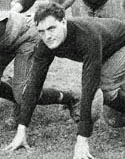
Bill Seip
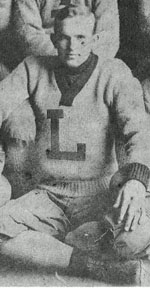
R. L. "Big" Stovall

Bob Smith
|
Part I | Part II | Part III
As the Tigers prepared for their game with Southwestern Presbyterian University (now Rhodes College) on Monday, October 26, the fans fretted over some "serious injuries" that befell the squad.
- Just returned from a bout with tonsilitis, E Bill Seip dislocated his left elbow while practicing on Wednesday. He was expected to miss the rest of the season.
- The same day, QB Jonnie Albright was knocked out in the scrimmage between the Varsity and the Scrubs. He was unconscious for some time before being taken to the hospital. Nevertheless, his condition was not regarded as serious. (No concussion protocols in 1908.)
- "Little" Stovall seriously injured his nose again while "Big" Stovall continued to have a "black knee."
Southwestern was expected to give LSU a rough time.
- The squad from Clarksville TN had given Vanderbilt a tough game, losing 11-5. Since the Commodores were considered champions of the South for 1907, the game with Southwestern would provide a barometer for measuring how good LSU really was.
- The Lynx also defeated Cumberland and Mississippi A&M (now Mississippi State, although MSU doesn't list the game in their results for 1908) as well as "several other teams."
- Tickets for the SPU game would be given to deaf and dumb students.
The 1,500 fans who gathered expecting to see a tighty contested game instead saw one that was one-sided from beginning to end.
- The Daily State-Times summarized the game thus:
At no time during the afternoon was L.S.U.'s goal line even in danger. The Tennessee boys did not make ten yards gain during the entire afternoon that they were able to hold for even a few minutes. What few gains the Clarksville boys were able to make, they made through punts, and by means of the forward pass. ...
As a result of the crippled condition of the visitors, their players were frequently knocked out, substitutes had to be used, and the game delayed for time to be taken out for the players.
- SPU's best player, Allen, got off some good punts but was not able to last to the second half because of injuries.
- Hitting the LSU line was like hitting a stone wall. The Tigers gained most of their yardage around the ends, especially right end.
- The game, while rough, was free of any slugging and "unfair playing."
First Half
- Southwestern won the "toss-up" and chose to defend the north goal. Fenton boomed the kick 40y. Stokes returned the pigskin 20y. Allen immediately punted back 40y.
Lally circled right end for 25. Then Fenton passed to Reuben Gill for 10 more. Doc then toted the ball around right end for the first touchdown 2:30 into the game. He also kicked the goal to make the score 6-0.
With LSU electing to receive the kickoff, Allen booted 40y to Smith who covered half the distance back. Fenton punted, but Allen kicked it right back.
Lally carried around right end for 20. Then a punt went out of bounds. But, again, the Presbyterians wanted no part of the ball and kicked it back, Fenton catching and punting to his teammate, Willie Hillman, who carried the ball over the goal from the 15. Lally kicked the point this time to make it 12-0.
Allen kicked off again for 40y, Lally returning 20. Fenton threw a pass to C. Smith for 30. Stovall, wearing a rubber nose guard, went around right end for 30 more. But on the next snap, a forward pass fell to the ground, and Marion covered it to gain possession for SPU.
Rodgers then shot a pass to Allen, but the ball fell incomplete. However, McLaurin fell on the loose ball to keep possession. On the next play, Allen punted.
LSU made steady gains until Bob Smith shot through center from the 5 for a touchdown. Fenton's goal moved the score to 18-0.
Allen kicked off again for 35y, Fenton making just a short return. On the next play from scrimmage, Allen got hold of the ball and punted. Gill made a fair catch which enabled Fenton to try a free kick from the visitors' 45 that added 4 points to LSU's tally.
The half ended with Presbyterian in possession on their 25.
Second half
- After a 25 minute first half, the second half lasted only 20.
The original starting lineups returned, but a few minutes in, Rathrock replaced Allen at LH, and Coach Wingard sent in an entirely new eleven for LSU.
Allen kicked to the 20, where Fenton received and punted back 40y. Possession see-sawed as a result of several punts.
Finally, Bob Smith rambled 20y before Lally went around right end, LSU's favorite place all day, for a touchdown. Fenton missed the goal to leave the score 23-0.
It took the Tigers only two minutes to score again. Bob Smith did the honors on a 10y plunge through C. Fenton kicked the goal. 39-0
Doc made the next touchdown as a result of still another right end run, this one for 30y. Then he added the PAT. 45-0
After the visitors had possession for awhile, Fenton received a kick and again used the free kick rule to boom another field goal. 49-0
A pretty 35y run by Gandy and a extra point kick by Fenton completed the scoring. Final: 55-0
|
The Tigers now hit the road to play Alabama Polytechnic (Auburn) on Saturday, October 31.
- LSU had met Auburn three times, losing twice.
- Mike Donahue, who, like Wingard, learned football in the North - at Yale, was in his fourth year as coach after a one-year interruption. His squad was undefeated and unscored on in four games against Howard (today's Samford), Gordon College (Barnesville GA), Mercer, and Sewanee. (Donahue would coach Auburn until 1923, when he came to LSU.)
- Wingard called his next foe "a splendid team." They have two very good coaches, one for the back field, the other for the line. They have practically all of last year's Varsity. McLaurin at quarter is a splendid general but he will have a good opponent in Fenton.
- However, the Tiger coach didn't consider Auburn's first four victims to be strong foes comparable to Texas A&M or Southwestern.
- He opined that his team was improving at a rapid pace. The men are willing and have the spurt that brings results. As an example, in the game of Monday several of my men were in bad shape, and when I sent in substitutes to take their places they were heart-broken to think that they had committed an offense.
- Wingard worried about the 178-162 average weight advantage the Alabamians would enjoy. Also, Auburn is in fine condition while we have several of our stars injured. Seip, one of the best if not the very best, end in the South, may not play, and if he does he will be sorely handicapped. The same can be said of Stovall, Sr., who is by far the best man for his weight in the South today.
- The Baton Rouge New Advocate proclaimed LSU "first in the South" over Vanderbilt on the basis of comparative scores. The writer added, Baton Rouge is football crazy.
- A Mobile group put up a $375 guarantee to get the game moved to their city without success. LSU tried to transfer the site to Baton Rouge to no avail.
- The 15-man Tiger squad made the trip on Thursday by train along with 800 enthusiastic fans.
 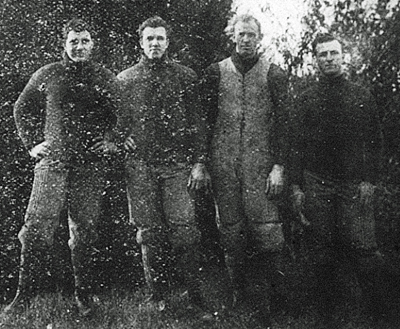
L: Auburn coach Mike Donahue; R: Four from his 1908 squad: John Davis, T.C. Locke, Bonner, and Homer Cogdell
A "tremendous crowd" witnessed what multiple reports called the roughest and most hard-fought game ever seen at Auburn.
- The newspaper report said: The fame of L.S.U. has preceded the team, and every Auburn supporter realized that the Polytechnic boys had the fight of their lives on their hands if they hoped to keep up their winning lick.
- Back in the Louisiana capital, a large crowd gathered at the telegraph office to await reports from the game.
- Fenton recalled years later: The game wasn't played on a football field. It was more like a sandhill. Fans were crowded all around the field and you had that hemmed-in feeling. A rope was the only thing that held them back.
First half
- LSU kicked off, Walker Reynolds returning 15y. A fumble immediately gave LSU the ball, but the Tigers failed to gain a first down on three tries to turn the ball over on downs.
After two plays, Auburn punted. LSU gained 11y by end runs and then surprised the defense with back-to-back forward passes. The first, to Lally, netted 40y to the 35.
Seip caught the next one and raced to a touchdown after ten minutes of play. Fenton's kick failed, making the score 5-0.
Auburn "by hard plunging" managed to work the ball to LSU's 30. Gandy was ejected at that point along with Daniel Herren of Auburn for fighting. Fenton: That Gandy had some temper, and one of my jobs was to try and keep him cool. I forget what game it was, but he grabbed an opposing player one time and tossed him into an eight-piece string band just behind the ropes, busting most of the instruments. He was tossed out of that one too.
A few minutes later, LSU found itself backed up to its 10 because of a roughness penalty. So Fenton dropped back to punt. Doc recalled what happened next: I was kicking from behind my own goal, and an Auburn tackle [T.C. Locke] broke through to block it. The ball was bouncing around so I picked it up and was getting ready to run it out of the end zone when a fan reached over the rope and cracked me over the head with a cane. It knocked me cold. The safety made the score 5-2 at the half.
- When LSU retired at halftime to a room near the field, Wingard's wife welcomed them. Her husband had given many a rousing speech, but her exhortation to win for "dear old LSU" was long remembered. All during her speech, Auburn students pelted the tin roof with rocks. That only made us madder, said Fenton.
Second half
- Fenton returned Reynolds' kickoff 45y. Both teams made futile attempts at ground gaining. LSU tried a place kick from midfield (the 55) but failed. Auburn returned it and tried a kick of its own, which also failed. "Louisiana" tried another free kick to no avail, Auburn returning to its 35. Reynolds punted 50y to Fenton, who returned 35. LSU then resorted to "straight football" (that is, no forward passing) to put the game on ice. After a short gain up the middle, then 3y around right end, the fullback gained 10 over C to the 15. Lally then carried the pigskin around left end and across the goal from there. The PAT was again missed to make the score 10-2. Neither team threatened after that.
Those would be the only points scored on Auburn that season as they defeated Georgia Tech and Georgia by a combined 67 points.
When the Tigers returned to Baton Rouge that night, the student body and hundreds of townspeople gave them a wild reception.
- 600 cadets, each carrying a horn, cow bell, or some other noise-making device, marched in a parade through the downtown streets.
- Each cadet had stamped his shirt with the score of the game.
- The team sat on the stage the next day for the Sunday chapel service. Each player said something as did the "prominent men from the city" who were present. President Boyd proclaimed, We have reached the proudest moment of the athletic career of the university.
- The celebration continued in the mess hall that night when the cadets gave yell after yell, some for individual players.
- The day ended with another parade through the city. Cadets in nightshirts marched in lines of twos behind the band. The students yelled, sang, and counted off the score. The crowd attended the theater where the wild and joyous shouts of victory continued.
- Despite the furious action, LSU reported no serious injuries.
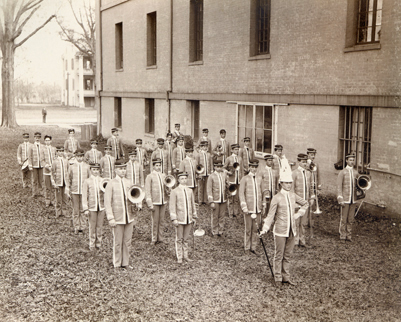
LSU Cadet Band c. 1900 As word of the LSU triumph spread around the South, many wondered if Wingard's squad contained many "ringers," players for hire who were not students of the university.
Continued below ...
This series of articles chronicles LSU's first undefeated season of more than three games.
The campaign would involve a heated eligibility challenge.
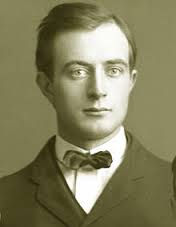
Dan McGugin

Warren Easton
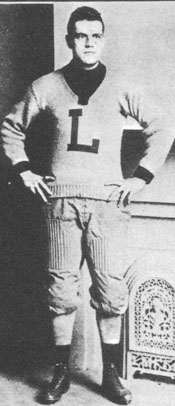
John Jacob Seip

Colonel Thomas D. Boyd

Mississippi Aggies Coach
Fred Furman
|
After defeating Auburn, LSU hoped to convince mighty Vanderbilt to play them for the championship of the South.
- Dan McGugin's Commodores had just returned to Nashville from a trip to his alma mater, Michigan. Fielding Yost's Wolverines socked the visitors 24-6.
- After hosting cross-state rival Tennessee, McGugin's boys would receive a visit from another Midwest team, Ohio State, before closing with Washington of St. Louis and Sewanee.
- So LSU's manager, R. L. Himes, perhaps naively, hoped to convince McGugin to schedule a game with the Tigers on either December 5 or 12.
Humorous story about Dan McGugin and his brother-in-law Fielding Yost
Closer to home, Warren Easton, chairman of the Louisiana State University Alumni Committee, scheduled a "peace conference" with a similar committee from Tulane, which had not played LSU since 1905.
- The purpose of the confab would be to draw up rules of eligibility to govern all future football and baseball contests between the two schools. Ideally, the committees could reach an accord in time for LSU and Tulane to meet on the gridiron in December.
- State followed the eligibility rules of the Southern Intercollegiate Athletic Association. But Tulane, deeming those regulations too lenient and not consistently enforced, had resigned from the SIAA several years earlier.
- Informal talks while LSU was in New Orleans in October to play Texas A&M had gone nowhere.
But the November 7 meeting failed to produce any progress.
- LSU's representatives again proposed that the game be played under the SIAA rules and pointed out that Tulane played Mississippi A&M with that same stipulation.
- But the Tulane representatives refused to agree to the contest because they did not believe that LSU had obeyed the SIAA rules. Tulane's statement released to the media read in part: Some of their adherents have rushed into print openly charging us with cowardice and challenging us for proofs of any wrong-doing on their part. Under these circumstances we have no alternative but to state to our friends and the public the specific reason why we will not play L.S.U. under the S.I.A.A. rules. The specific reason is that we have sufficient concrete evidence to prove definitely that L.S.U. violated the rules of the S.I.A.A. last year and is violating them again this year. It has been enabled to do so by the very fact that those rules do not require each college to furnish the other the specific information which we now demand. The concrete evidence to which we now refer establishes the following facts:
First - The Captain of the L.S.U. football team last season ... who was registered in the University catalogue for last year as Charles Cecil Bauer, "special" student from Winn Parish, taking a course in "bookkeeping," was in fact a hired professional athlete named Charles Ora Buser, living in Indianapolis, Ind., and, according to his own statement, brought to Baton Rouge by Coach Wingard, who paid him handsomely for his services. He is 30 years of age ... [Tulane furnished a letter, allegedly from Bauer/Buser in Indianapolis, offering his services to them for the 1908 season. Tulane hired a Pinkerton detective who interviewed Buser and learned his real name and the fact that Wingard had paid him well for his services.]
Second. John Jacob Seip, who played last year on the L.S.U. team and is again a member of it, was brought down from Pennsylvania last fall by Coach Wingard. He played on the team of the Susquehanna University in 1906, and, accordingly, was ineligible to play last year ... Seip... should be held to have become thereby permanently ineligible as a bone fide contestant under the S.I.A.A. rules. ...
Third. We have strong reason to believe that there are now two men on the L.S.U. football team whose correct names are Lesher (or Lecher) and Phillips, were imported or induced to come from Susquehanna University ... by Coach Wingard. ...
Fourth. The Smith brothers who played on the L.S.U. team in 1905-06, were imported from Michigan and hired to play on the L.S.U. team in 1905. They thereby became permanently ineligible under the S.I.A.A. rules ..., but they are members of the team this year. ...
We positively decline to bring our students into contact with hired men, professional athletes ... men upwards of thirty years of age ... We can see no satisfaction in any honest or patriotic Louisianian in a champion "Louisiana" college team, the strength and prowess of which is supplied chiefly by men who are not bona fide students, but imported from every state but Louisiana.
Colonel T. D. Boyd, the president of L.S.U., made a statement the next day in response to the charges.
I now wish to declare to the people of Louisiana that every man on L.S.U.'s football team is a bona fide student of the University, and is, to the best of my knowledge and belief, fully eligible under all the rules of the Southern Intercollegiate Athletic Association to represent the University in intercollegiate athletic contests.
I have made this declaration before and have expressed my determination to remove from the team any man who could be shown to be tainted with professionalism or to be ineligible in any respect.
I shall now go a step further. Ignoring the principle of law that the accused is presumed to be innocent until his guilt is proven, I shall assume the burden of proof and convince every fair-minded person that these men are eligible. It may require several days to collect and arrange the necessary data ...
I have already invited Dr. William L. Dudley, the president of the S.I.A.A., to have this matter thoroughly investigated in any way he deems proper, and have extended a similar invitation to the athletic authorities of the Alabama Polytechnic Institute at Auburn.
The Daily State-Times of Baton Rouge defended the local university against Tulane's charges.
- Tulane hadn't proved anything except that Bauer was a ringer. But he was not on this year's team. He had signed an affidavit that he did not receive compensation for playing. If he perjured himself, the University authorities had no way of knowing it. If he was paid, it was not by the university but by someone in the city who thought they were a friend of LSU.
- The Smith brothers had been residents of Baton Rouge for three years and were taking a sugar chemistry course at L.S.U. ("Course" probably meant a "course of studies," not just an individual class.)
- Seip and Fenton were students of the university, as they were in '07, both with very good class records. Neither competed on the teams at Susquehanna.
- Lesher and Phillips were registered at L.S.U. under their right names and were playing on the "scrub team," having not been able to make the Varsity eleven. Phillips was the brother of Wingard's wife.
In the meantime, Wingard's squad hosted the Mississippi Aggies on Saturday, November 7 before over 1500 spectators in ideal weather conditions.
- The Tigers didn't anticipate much trouble in adding another victory, but the 50-0 margin was a surprise.
- Not once did the Starkvillians threaten the LSU goal line. They penetrated Tiger territory only a few times.
- Not making any headway through the middle of the Tiger line, the Aggies found even poorer results around the ends, usually being dropped for losses.
- Morris of the visitors consistently punted the ball 40-45y.
First half
- A&M won the toss and chose to kick. Kern kicked off 40y to Doc Fenton and returned to the 35. LSU scored its first touchdown in five and a half minutes of playing time by working the ball by end runs down the field to the 3, from where Bob Smith shot across the goal. Fenton failed to kick goal. 5-0 LSU
In less than two minutes, Fenton ran 45y to the end zone but the referee ruled that he was down further back. Apparently, the ball went over to the Aggies because, on the next play, LSU blocked a punt and gained a safety. 7-0
On the Tigers' next possession, Seip carried the ball around E for 85y and a touchdown. Fenton kicked the goal. 13-0
After LSU moved the ball to the 5, Clarence Smith ran through the line and planted the oval behind the goal. A&M blocked the extra point kick. 18-0
Back came the relentless Tigers. Smith followed Mike Lally's interference around E for the touchdown. 23-0
Kern kicked off for A&M. Fenton made the longest run of the season, when he caught the ball ... and, dodging with the agility of a rabbit the entire A. and M. team, carried the ball ninety yards down the field and behind the A. and M. goal. 28-0
Second half
- With the outcome no longer in doubt and another game scheduled three days later, Wingard changed his entire lineup during the half until only "scrubs" played.
Fenton took a punt back 30y. Hillman missed the PAT. 33-0
R. O. Gill made a 35y run around right end. Stovall booted the goal. 39-0
Fenton scored another touchdown, but the extra point failed. 44-0
Clarence Smith ran up the middle for the final touchdown. Lally kicked the goal. 50-0
|
Continued below.
|
Grantland Rice of the Nashville Tennessean, just seven years out of Vanderbilt where he played football and baseball, had already become the preeminent sports columnist in the South and attracted attention across the nation. In his "Sportograms" column for November 4, 1908, he acknowledged that LSU's victories over S.W.P.U. and Auburn showed that the Tiger squad was "the strongest in Dixie." Then, obviously influenced by the Tulane charges listed in the Times-Picayune, he wrote this.
Before championship laurels are pushed her way, it is advisable to wait and get the latest returns about the status of her team. ...
It is no matter of who wins a championship with us - simply that it shall be won fairly. Auburn this season has an eligible team. So has Sewanee. So has Tennessee, Georgia, Vanderbilt, Tech and others. Can L. S. U. say the same? Is it true that L.S.U.'s 1907 captain was playing under an assumed name? That L. S. U. has been offering inducements to crack athletes to enter her college this fall - or if not L. S. U., some one connected with the institution? If it isn't true - very well and good. You've got to hand it to the Baton Rouge team. If it is true - what claim has that college to anything in amateur circles?
Rice then added his own anecdote.
It all came about this way. The night that Chez Clarke, Rose Poly's coach, was in The Tennessean office, he offered this statement: "So they say L.S.U. is going to have a crack team. Well, I guess she ought to have." And then picking up the 1907 guide he picked out at least two men whom he said were playing under assumed names, one of them the team's captain - adding that he had been offered a good monthly salary to come down this fall - the only requirement being that he switch the title by which he was christened.
If L. S. U. can show that she has been done an injustice we will be more than pleased to present her side of the case.
Meanwhile, back in Baton Rouge, the Tigers had little time to gloat over their victory against the Mississippi Aggies.
- Four days later, November 10, Baylor provided the opposition.
- Led by their seventh coach in seven years, the Bears were completing a two-game Louisiana swing that began with an 11-2 loss to Tulane on Saturday, November 7.
- The Texans lone victory came at the expense of Texas A&M 6-5 on October 10. The Tigers had soundly beaten the Aggies 26-0.
|

Grantland Rice
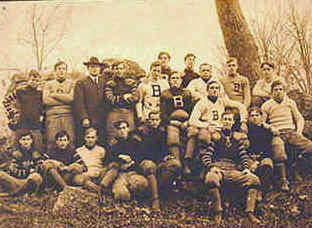
1908 Baylor Bears
|
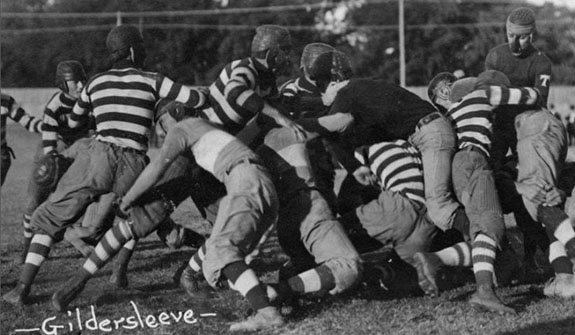 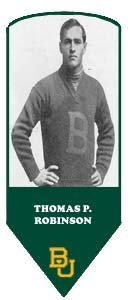
Action from Baylor-Texas game
October 17, 1908
Baylor hung in for ten minutes before the Purple and Gold Torrent overwhelmed them, scoring more points than the Bears allowed in their first five games combined.
First half
- At 3:34, Doc Fenton kicked off for LSU to Thomas Robinson of Baylor who was downed by Owen Noblett on Baylor's 10. Following the normal strategy of the era, Baylor immediately punted, Fenton returning to the visitors' 30.
Doc dodged, twisted, and squirmed through the defense, his hand on Bob Smith's shoulder, until finally downed on the 15. After two runs gained 6, FB Clarence Smith tore through a gaping hole for the first touchdown with but 2:22 elapsed. Fenton kicked the goal to make it 6-0 LSU.
Baylor kicked off to Fenton, who returned to the LSU 35. The ball then changed hands three times in a stretch of four plays, the last of which saw Fenton cut in front of a Baylor pass and return it to midfield.
R. R. Stovall, on a "double pass," threw the ball forward, resulting in a 15y penalty. So Fenton kicked to Puett of Baylor who made a nice return to midfield. Continuing the Bears' game of Hot Potato, Robinson kicked and John Fouts "saved the ball for Baylor on L.S.U.'s 35-yard line." (Does that mean the kick was blocked and Baylor recovered beyond the line of scrimmage?)
After losing 2y, Baylor tried a field goal. But LSU blocked the kick "and Baylor then lost the ball on a fumble in a scrimmage."
"L.S.U. gained through the line, but Fouts doubled up in front of the interference and the entire Louisiana eleven fell over him." Fenton passed to Stovall for a short gain, then threw another pass that fell incomplete which earned a 5y penalty. Noblett bucked C for 2, then Mike Lally gained 10 around E. "Little" Stovall followed with 15 more to the Baylor 25. From there Smith went up the middle for the second touchdown. Fenton missed on the PAT. LSU 11-0 with 10:30 expired.
After several punts, a pass to Seip put the pigskin at midfield (55y line). Fenton tore off a 45y run to the 10, then Smith plunged across. Fenton's try failed. LSU 16-0 13:18.
Lally received Baylor's kickoff but lost the ball on the 30. Puett and Robinson gained 15y between them followed by a 2y gain to move to the 12. But "Big" Stovall smashed through on the next play, tackling the Texas back for a 2y loss. Puett lost 3 more on the next snap. Then Baylor tried another field goal, but again LSU blocked it and recovered.
After a double pass gained a few yards, Fenton kicked "out of danger" to Puett, "who was almost knocked
out by a vicious neck tackle" at midfield. But he stayed in the game and gained 1 on the next snap before Robinson kicked to the 20, from where Fenton returned to the original line of scrimmage where he fumbled, Baylor regaining possession.
Again, the Bears kicked. Doc gathered in the pigskin on the 25 and made a "long run" that was called back. After the teams exchanged kicks, Lally ran to Baylor's 40. After gains by Sipe and Smith, Gandy plunged for 10, Noblett tore off 10 more, then Smith lost 3. Fenton was downed for a loss of 10. So Doc tried for a goal but failed. However, LSU was called for holding and penalized 10y.
So Fenton punted over the goal line.
Taking the ball on the 25, Baylor of course punted to C. Smith who returned to midfield. Lally gained 10, Smith 10, then Fenton for some reason punted and Baylor returned from the 25 to midfield.
Getting the ball right back, LSU drove to its fourth touchdown, which Fenton scored with 1:07 remaining. Doc also kicked the point to make it 22-0.
After Fenton returned the kickoff, Noblett, Gandy, and Fenton moved easily through the tired Baylor D for another touchdown. 27-0 with 0:40 left.
Once again Baylor kicked off. (If they had received the kick as in today's rule, they probably would have punted on first down anyway.) Lally "swept down the length of the field with his interference racing by his side, five yards inside the side line, down before the grand stand, bowling over Baylor players at every step - placing the ball behind the goal posts just ten seconds before the whistle blew for the end of the first half." The goal having been kicked, the score stood 33-0.
Second half
- "The second half was simply a runaway match. Baylor's men simply couldn't stand together. Individually they showed nerve and courage, but as an eleven they had ceaesd to exist."
Little Stovall ran 50y, Lally rumbled 60y, Fenton rambled 65. "Stovall ran eigty yards; Noblett ran, Gandy ran, everybody ran."
"Pluckily the Baylor men returned the punts and sought to keep the play up-field, but the Louisiana backs remorselessly smashed and plowed and dodged and squirmed and twisted through for any old distance any old time."
Albright replaced Fenton at QB and "raced the team up and down the field as blithely as though the evening had just begun."
"'Beat the soldier score!'[81-5 over Jackson Barracks earlier in the season] was the cry from a crowd that has ceased to be thrilled by mere fifteen and twenty-yard runs."
"'Make it a hundred and send word to Tulane,' called the side-lines."
Fenton kicked the final field goal to end the slaughter at 89-0.
The game set records that still stand at both: the most points ever surrendered and the greatest margin of defeat (by 12 points) by a Baylor team and the second most points and second largest margin by LSU (after 93-0 over SLI in 1936).
The same Daily State-Times page that contained the article on the Baylor game also contained the ad on the left below. The one at the right comes from the Times-Picayune of November 15.
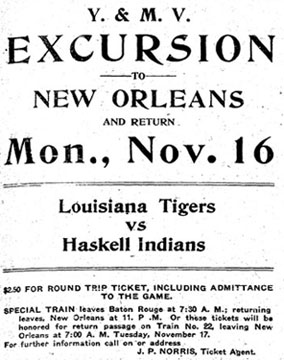 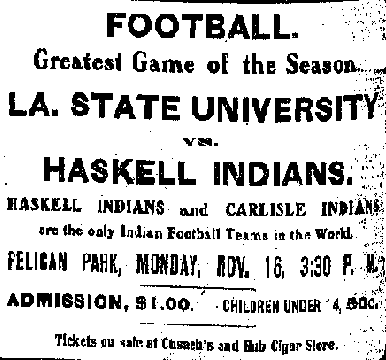
Haskell Institute was founded in Lawrence KS in 1884 as a boarding-school for American Indian students.
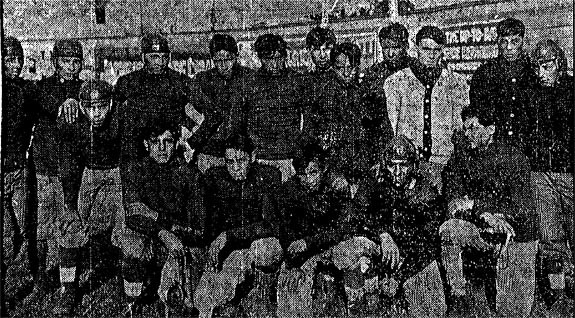
1908 Haskell Indians
The game on Monday, November 16, created even more controversy for the Tigers but not because of questions about eligibility. Rather, it was charges of biased officiating that made news. As Peter Finney wrote in his The Fighting Tigers: LSU Football 1893-1980:
Judging from reports, the officials made up for the scalping Sitting Bull handed General Custer at Little Big Horn. The Indians wept openly at the calls which repeatedly went against them, and it wasn't long before the game got out of hand.
Almost 3,000 fans, including 900 arriving on the special train from Baton Rouge, gathered on a clear day with maximum temperature of 61°. They saw what Referee Jim Halligan later recalled as "the roughest football game I ever saw."
First half
- LSU won the toss and chose to kick. Fenton booted to the 10 from where Kalamas returned 20y. On the first snap, the Tigers "surged over on the oppressed 'Injuns" before the ball had been snap, causing a fumble that captain Gandy recovered on the 20. Many onlookers thought LSU was offside, but the officials didn't call the penalty.
Fenton skirted left end for 5. Clarence Smith "on a beautifully executed fake kick" ran over the goal behind splendid interference. Fenton added the point, and LSU led 6-0 one minute into the fray. The Tiger partisans roared for five minutes.
Doc boomed the kickoff over the goal line, and Island ran it back to the 12. Baird immediately punted to midfield.
C. Smith and Noblett made short gains before it was LSU's turn to lose the ball on a fumble. Baird bucked 2y, then punted, Fenton returning to midfield.
Seip gained 5 on an end sweep, but Bob Smith fumbled the ball away on the next play.
The fumbleitis continue but Good Eagle recovered his own bobble. Fenton then fair caught Baird's punt on Haskell's 46.
Fenton tried a free place kick but missed. Haskell took over at the 25 after the touchback but punted immediately. "Captain Ireland was here forced to leave the game on account of being unable to stand the grind."
After an exchange of punts, Lally skirted left end for 7, and Bob Smith plunged 3. But when Fenton faded to pass, Delonia hit him 15y behind the line and caused a fumble, the Indians recovering.
A "triple forward pass" netted 40y to the LSU 15. "Haskell's chance to score was excellent, but when Dunlap, the Indian center, started to snap the ball on the next set of signals being called Stovall crashed through and the Indians lost the ball to the beleaguered Louisianians."
C. Smith gained 10 over T, but Doc chose to punt on the next play.
Haskell tried a pass on first down, but Fenton intercepted near midfield.
However, LSU could do nothing, going nowhere on two runs. So Fenton sailed the oval behind the visitors' goal line. DeWitt foolishly tried to run the ball out but was downed on the 2.
After LSU was penalized 5y for offside, Baird punted to Fenton at midfield.
Noblett bucked for 9, but Fenton was tackled while trying to throw a pass and lost 20. "An offside kick [?] resulted in a good gain for the Tigers," and Bob Smith plunged to the 25. Doc tried a field goal but missed.
The Indians punted out to midfield. Seip was thrown for an 8y loss on first down. Then Pappari stopped Lally for no gain.
An offside kick to Fenton moved the ball to Haskell's 40. Lally failed to gain "in the next fierce scrimmage and Referee Halligan chased Roberts, the Indian right tackle, for slugging." The 20y penalty placed the pigskin on the 20. On the next snap, Lally fumbled but a Tiger just beat an Indian defender to the ball for a 10y loss. After Bob Smith's short gain, Fenton tried another kick from placement and this time split the uprights. LSU 10-0 with five minutes left before the break.
Baird kicked off to the 20. Lally circled right end for 15, but Fenton was thrown for a loss. So he punted to the Indians' 40, but Baird kicked back to LSU's 40.
Bob Smith gained 6 off tackle, and Noblett added 4 more. Smith again for 2 before Seip and Lally made short gains. LSU was penalized 15y for holding, forcing Fenton to punt, the ball going out of bounds on the Haskell 35.
But Baird booted right back, Seip making a fair catch on his 40. Fenton punted to the 10 as time expired.
When the LSU band climbed over the fence onto the field to perform at halftime, about 500 "vociferous college boys from L.S.U. and Tulane" followed them. When the show ended, the band and students were allowed to throng the sidelines. As a result, the game was halted several times during the second half "on account of people crowding on the field."
Second half
- Fenton kicked off to the 20. DeWitt shot a pass to Pappan for a 20y gain. How do you keep that momentum going? You punt the ball! But Gandy broke through and blocked the kick, advancing the ball 20y "with what seemed to be half the Indian team on his back" "before being downed by a fierce tackle of Good Eagle."
Fenton swept E for 9 to the 10. Noblett gained 6 before Gandy shot over for the touchdown. Fenton's goal made it 16-0 after two minutes of play.
After "a rapid exchange of long punts," LSU had possession at its 50. (110y field, remember.) Lally, Fenton, and Noblet gained ground before LSU was penalized 15y for holding. Fenton then flashed around right end for 25. "Kalamas was ejected from the game on the charge of attempting to kick the flaxen-haired quarter after his fierce tackle."
The penalty moved the ball to the 2 from where Bob Smith took it in. Fenton's kick missed. LSU 21-0 after seven minutes.
The Tigers decided to kick off this time, but it really didn't matter the way football was played in 1908. A "brisk exchange of punts" ensued after which LSU drove to another touchdown. R. L. Stovall took a pass for 10y. Gandy plunged 4, and Bob Smith ripped off 10 over T to the 25. C. Smith followed "magnificent interference" around left end for the score. Fenton missed the goal. LSU 26-0.
After more punts, a clash between J. H. Stovall and "Big Chief" Baird resulted in both being ejected. The game was delayed 10 minutes by "what threatened to be a small riot." (States-Times) "Excited beyond measure by imagined injuries received, the Indians were as eager to scrap as the Louisiana boys. The pent-up grief over the seemingly hostile attitude of the officials of the game toward them had the Haskell braves badly rattled. The game was delayed on several occasions during the last half on account of people crowding on the field." (TP)
After another pair of punts, LSU drove 65y for their final score. The drive started poorly when Fenton was thrown for a 5y loss. But Bob Smith circled left end for 40y. Two plays later, Lally sprinted around right end for the touch. Fenton kicked goal to make the final score 32-0.
Postgame comments
- LSU Coach Wingard: The Tigers were slowly aroused, but their work during the latter part of the game was gratifying, and as the Haskell Indians have a good team, the score was satisfactory. The Redskins worked hard, but I was never uneasy over the result after the first half.
- Haskell Coach Kent: We were beaten because our men lacked the experience of the Louisiana veterans. I really don't care to say anything regarding our treatment by the officials. What's the use?
The Times-Picayune writer sympathized with Kent.
Time after time Haskell players were ejected from the game for alleged slugging, much to the disgust of a great many impartial spectators. Although Louisiana players several times hurdled, held, or employed other foul and illegal tactics, they were penalized only a few times, and R. L. Stovall, who engaged in a flat fight with "Big Chief" Baird, was the only L.S.U. man chased from the game. ...
Many times the Indians were exasperated enough to weep at the seeming partiality of the officials, and on several occasions they threatened to throw up the sponge and quit, but the long contest was played to the end and it was nearly dark when time was finally called.
One of the spectators at Pelican Park was Ty Cobb, "famed right fielder of the Detroit American League champions" who led the Junior Circuit in batting for the 1908 season.
- Ty had made his first trip to New Orleans to play in exhibition games over the weekend at Eddy's Park (a block from the intersection of S. Carrollton and S. Claiborne).
- Disgusted with the field being overrun with people in the second half, Cobb told newsmen covering the event, "You people over here don't seem to know how to run a game."
- Persuaded to leave his seat in the grandstand and join the throng on the sidelines, Ty asked the officials, "Can't you see that Louisiana man holding every time. What's the matter, umps? Pray, prop open those peepers!"
- It's interesting that the Georgia Peach, a blatant racist regarding African-Americans, sympathized with Native Americans.
- Although he had never played football, he knew the game and criticized the Indians for not having any interference.
- Cobb opined that, although they were beaten by Auburn, the Sewanee Tigers could lick Louisiana.
Referee Halligan felt compelled to write a letter to the Picayune defending his work.
- He said that Coach Kent had commended his work after the game and even tried to hire him to work his game with Alabama a few days later.
- Umpire Joe Pritchard became LSU's coach for 1909.
Continued below ...
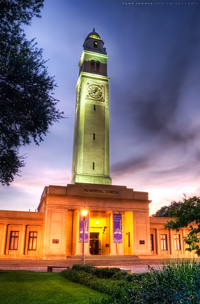
Boyd Memorial Tower, dedicated
on
the current LSU campus in 1926

Coach Edgar Wingard
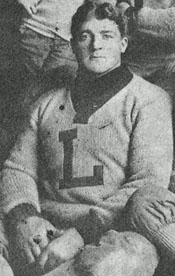
Oren Noblett
|
LSU President Colonel Thomas Boyd published an affidavit he filed on November 20 in East Baton Rouge Parish attesting to the fact that every player on the LSU squad complied with the rules of the Southern Intercollegiate Athletic Association.
... each and every one of them are bona fide students of the Louisiana State University ..., pursuing therein courses of study that require at least the number of hours of lectures and recitations proscribed by the Constitution of the Southern Intercollegiate Athletic Association; that they have read the Constitution and Bylaws of 1908 of the [SIAA] and are eligible under all of the rules therein contained ... and specifically that they have never at any time or place, directly or indirectly, received compensation or lucrative employment upon the understanding or condition, expressed or implied, that they should play football or any other sport.
Boyd also had each player file an affidavit testifying to his eligibility.
Coach Wingard swore in his affidavit that to the best of his information and belief, each and every player on the [LSU] football team is eligible under the rules of the S. I. A. A.; that as to the matters set forth in the said charges [from Tulane and others] ... that the same are unqualifiedly false and defamatory and, in the belief of this affiant, prompted by malice against Louisiana State University.
With efforts to arrange a post-season game with either Tulane or Vanderbilt going nowhere, the Tigers embarked on a two-game road trip to end the season.
- The first stop would be Ruston for a clash with the Louisiana Industrial Institute (which would be renamed Louisiana Polytechnic Institute in 1921) on Monday, November 23.
- LSU would then continue north to Little Rock for a Thanksgiving contest against Arkansas.
- The Tigers were expected to run up the score on both opponents in order to impress sportswriters around the South.
Joe Prichard, former Vanderbilt star who umpired LSU's game against the Haskell Indians, had no doubt that the Tigers were the best eleven in the South.
Slip your wheels of time back about two months and you will remember an article that I wrote that predicted one of the best football teams ever put out in the South would be turned out here at Louisiana, and that was one time that a non-prophet told the truth for the future. For where is there a football team in the South, or anywhere else, that is the powerful scoring machine as this team which Coach Wingard has been polishing, cutting, oiling, and nursing for the past two months?
The team is not only a scoring machine, but it is a wonder when it comes to defense, for there has not been but seven or eight first downs made on this team the whole year.
The development of the team has been ideal in every respect on account of the great care and skill that Coach Wingard has exercised in bringing it to perfection. ...
The real test of the year was the game with Auburn, which was away from home, on a slow, sandy field. Yet what did the Tigers - full-grown now - do? They beat the best team in the South. The game was won on its merits, and every man on the Auburn team will tell you the same. The Louisiana boys came out of the game without a scratch or bruise to amount to anything. ...
I do not believe this team has reached its perfection yet. Wait and see for yourself.
|
Coach Furman of Mississippi A&M, whom the Tigers lambasted 50-0, agreed and addressed the accusations against the team in an article in the Daily State-Times.
I think that L. S. U. has far the best team in the South. Her line is old, experienced, aggressive, heavy; her ends are especially fine. Seip weighs over 200 pounds and can sprint the hundred close to ten flat.
It is Louisiana's backfield, though, that brings joy to the fan's heart. Fenton is the best quarter I ever saw on a field, and I've seen some of the good ones. His headwork, his offense, his defense, his punting are marvelous. Lally is less useful advancing the ball, but his interference is better than I have seen from anybody in years, and his defense is perfect. The Smith brothers are stars, but beside these men their work is inconspicuous.
The charges being made against Louisiana are serious indeed, but if they are not better founded than appear on the surface, they are fated to fall flat. Fenton and Lally came to L. S. U. from Mansfield State Normal, Pennsylvania, where their strict amateur status was never questioned. Assistant Coach Bobson, of Georgia Tech, is quoted as calling them ex-Peddle Institute [NJ] men. That is a mistake, as I remember Lally was there during the fall of 1906, his second year at Mansfield, for about three days. Fenton never was there. They are playing under their own names, and I don't think that they receive any remuneration.
The explanation of their presence in the South looks simple to me. They are from the school that sent Davis to Princeton; ... and other stars to other colleges.
Now these boys wanted to play football, too, and probably found that they could enter L. S. U. with less preparation than is required at the great Eastern Universities. At any rate, my knowledge of them is too great to permit me to believe an unsupported charge of professionalism against them.
If Vanderbilt refuses to play them, the South will miss a grand exhibition of the best game ever devised.
The day of the Louisiana Institute game, an article appeared in which Wingard refuted the characterization of his team as "heavy."
- The average weight of the varsity team was only 168 pounds and not the 185 that was widely claimed. The average of the entire squad was only 157.
- The heaviest player, by a large margin, was T Oren Noblett at 230 lb. Then came a cluster of players in the 170s starting with HB Clarence Smith at 178, G Arthur Thomas (176), T Marshall Gandy (175), G Bill Pollock (173), G Willie Hillman (172), and Bob Smith (171).
- The tallest Tigers were Gandy, HB Pat Ryan, and E John Seip at 6' 1". Six others stood an even 6'.
- The oldest man was Clarence Smith at 27, followed by his brother Bob (24), then Thomas and Hillman (23).
- QB Doc Fenton was listed as 21 years old, 5' 9", 165.
Wingard, Manager Himes, and 14 players arrived in Ruston the day before the game.
- The Ruston school had played LSU every season since football began at the Institute in 1901.
- Coach A. L. Cornell's '08 squad had won four of their seven games. Their only common opponent with LSU was Mississippi A&M, which walloped the Bulldogs 47-0 in Starkville.
- The largest crowd ever assembled at the Louisiana Industrial Institute Athletic Park to witness a football game saw the home team play surprisingly close during the 15-minute first half.
- The expected rout didn't occur in the second half either as LSU prevailed by only 22-0.
First half
- LSU found opponents today worthy of their best efforts, together with the plucky, determined and ofttimes successful plays of the Institute men, constituted an exhibition of ball playing that delighted all who love the game.
The Tigers shut down the Rustonites but could score only 11 points themselves.
Seip scored the first touchdown and Fenton the second. Doc also kicked the extra point after one of the scores.
Second half
- Soon after the resumption of play, Noblett suffered an ugly gash under his right eye in a collision with Smith of L.I.I. but continued in the game.
Near the end of the game, Fenton ripped off a "splendid" 50y run for his second touchdown of the half, after which he was seized with cramps. Albright replaced him.
The Tigers proceeded to Little Rock to meet Arkansas.
- The Cardinals (as they were called then) had first played LSU in 1901, losing 15-0 in Baton Rouge.
- The teams played again in 1906 and 1907 in Baton Rouge, tying the first 6-6 and LSU winning 17-12 in '07.
- The '08 Cardinals had compiled a 5-3 record under first-year coach Hugo Bezdek. Their only common opponent with LSU was Haskell, which fell 6-0 in Fayetteville. They also defeated Ole Miss 33-0.
- Arkansas made the game what, in a later decade, would be called Homecoming, urging alumni to support their alma mater.
- Thanksgiving was a popular day for football as evidenced by these games scheduled that same day: Sewanee-Vanderbilt in Nashville, Auburn-Georgia at Montgomery, and Tulane-Washington (St. Louis) in New Orleans. The big game in the East was Cornell-Pennsylvania. In another contest of national interest, the Carlisle Indians traveled to the Mound City to meet St. Louis University.
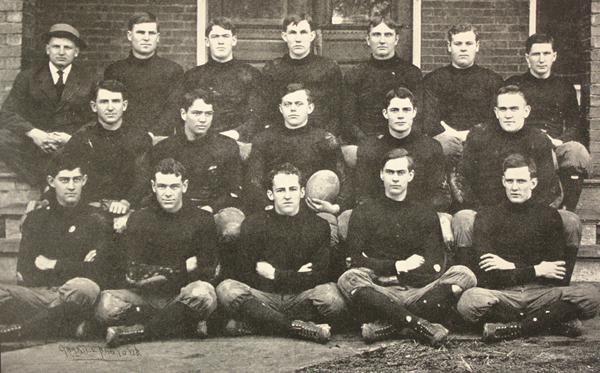
1908 Arkansas Cardinals
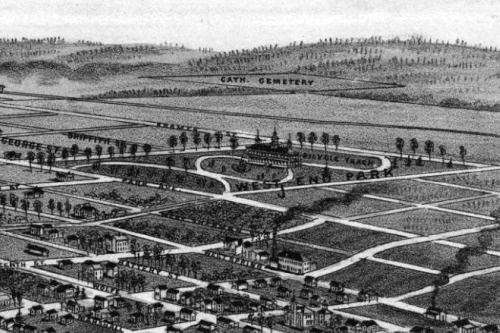
Little Rock West End Park 1887
5,000 at West End Park, including a large number of the student body who traveled by train from Fayetteville, saw the Tigers waste no time in establishing their superiority.
First half
- LSU scored 18 points in the first four minutes.
Winning the toss, the visitors chose to kick off. Nelson caught the ball on the 5 and returned 10y. Orrick gained 5 "on an on-side kick," but Arkansas soon had to kick, Phillips punting 25y and LSU returning 10.
Fenton went 32y around right end. Then Mike Lally followed up with a 40y jaunt across the goal. Fenton kicked goal to make it 6-0.
LSU kicked to Fleming who returned from the 5 to the 25.
Arkansas tried a pass, but Fenton intercepted and ran it back 45y for a touchdown.
The Cardinals kicked to Stovall, who booted it right back. R. L. Stovall recovered the ball and ran it over for another touchdown.
Arkansas stabilized after the opening blitz and regained its feet to a certain extent. Midway through, they got on the scoreboard with a 30y field goal by Fleming.
Wingard later told the New Advocate that after LSU scored 16 points in the first minutes, the umpire got busy and began to penalize the Baton Rougeans.
The Cards were aided in getting close enough for the kick by a 15y penalty against LSU for slugging. Wingard said that the umpire ejected the player after I had given him my word as coach that he did not do anything of the kind.
Seip added a touchdown and R. L. tallied his second 5-pointer to make the score 30-4 at the break.
Second half
- Fenton scored the only touchdown of the half on a 35y left end sweep after faking a forward pass. Four defenders made flying leaps at him but couldn't hold on. Doc completed a perfect day in the extra point department with his sixth conversion.
Fleming tried another field goal but it sailed underneath the crossbar.
The only gains of consequence made by Arkansas were on short forward passes and on side kicks.
The margin was not wider in part because of the numerous holding and offside penalties on the visitors amounting to 90y in all. At one point, Clarence Smith returned a kickoff 90y for a touchdown only to have the score nullified by a holding penalty.
Arkansas was penalized three times in the second half for throwing incomplete forward passes.
Fenton's punts averaged 45y.
The two teams attended a dance at the boathouse that evening. LSU attempted to arrange a game with "a picked team from the fort and local athletic club," but there is no record of any such contest being played.
The State-Times headline for November 27 proclaimed LSU CHAMPIONS OF THE SOUTHERN STATES.
- L. S. U. FOOTBALL TEAM HAS MADE WONDERFUL right endCORD
TEAM HAS TOTAL 442 POINTS
- L. S. U. closes the most remarkable football season of any Southern university. The team not only closes the season as champions of the South, but has this title by such an immense score that it is undisputed. ... the opposing teams this year were unable to score but 11 points. Only one of those was a touchdown, this being made on a fluke play by the army of New Orleans.
- When the team arrived "from its final triumphant trip to Little Rock" at 5:30 Saturday morning, Colonel Thomas Boyd, the LSU president, a group of professors, a delegation of cadets, and the cadet band greeted them.
After being heartily welcomed and cheered, the victors were ushered to the awaiting autos and carried to the University. ...
After a season of hard work, after a series of unprecedented victories, and after covering themselves, their coach, and their university with laurels, the Varsity football squad will be feasted, fostered and made much of. (Daily State-Times)
- Boyd hosted the 14 members of the traveling team along with Mr. and Mrs. Wingard at his home on the LSU campus on December 8. The Colonel presented each player a souvenir containing "L '08" and a miniature picture of the one to whom given.
Continued below ...
|
As November turned into December, the Tigers' hopes for a post-season game against Vanderbilt dwindled to nothing.
In the meantime, a number of Tigers received post-season honors.
Times-Picayune All-Southern Team
- C Willie Hillman
- RT Oren Noblett
- QB Doc Fenton
- right half Michael Lally
Coach Wingard wrote an article for the Spalding Football Guide extolling his team. The New Orleans Item summarized the views Edgar propounded.
Excusing himself for picking so many Louisiana State men on his All- Southern team by saying that he does not think there is a team in the South that could hold L. S. U. to a close score, much less defeat her, Coach Wingard gives the Eastern critics one or two things to think about.
While Coach Heisman, Grantland Rice and other football men of authority in the East have been picking Vanderbilt, Sewanee, Auburn and Georgia men and ignoring the real championship team of the South. Wingard frankly declares that his team could romp away with anything that the East can trot out.
Wingard may be just a little too partisan, though. It would appear that way when he says that for a tri-state team for Louisiana, Mississippi and Arkansas he would pick the whole L. S. U. eleven. He even goes so far as to say that he doesn't believe another man on any eleven in any of the three States would make the Louisiana Varsity. On this tri-state team he makes Gill first substitute.
Item All-Southern team
- C "Big" Stovall
- T Noblett
- QB Fenton
- HB Lally
Wingard's comments:
- Fenton and Lally ... have no equals in the South and are head and shoulders above other backfielders.
- As center, Luther Stovall ... has never met his equal.
- The Auburn game was played on a sand hill. Football critics all over the South who saw that game know that on a solid gridiron Louisiana could defeat Auburn 24 points. I am of that same opinion.
Not all the newspapers shunned LSU because of its alleged use of ineligible players.
- T. N. Buckingham of the Memphis Commercial Appeal placed LSU first in the South.
- He included Fenton at QB, Lally HB, and Hillman at G on his All-Southern team.
In mid-December, LSU president Colonel T. D. Boyd attended the 15th annual meeting of the directors of the Southern Intercollegiate Athletic Association in Nashville.
- The directors appointed a committee to investigate charges that LSU used ineligible players during its undefeated season.
- The committee consisted of Chancellor B. Lawton Wiggins of Sewanee, Professor B. M. Walker of Mississippi A&M, and Professor Barnwell of Alabama.
- The committee planned a visit to Baton Rouge in January to look into the charges of professionalism and other violations of SIAA rules.
The directors also approved the eligibility rules for the 1909 football season.
- Any student entering a college from a secondary high or preparatory school who can show 14 Carnegie units of credit will be eligible to play his first year in college.
- No student going from one college to another, regardless of whether he has played on a college team the preceding or at any other time will be eligible to play on the team of his new college for one year. This was an important change from the '08 rules which did not mandate the yearlong waiting period. (This rule continues to this day in the NCAA.)
As 1909 began, Clarence Smith contracted typhoid fever and spent several weeks in the hospital before succumbing to the disease January 21.
|

Willie Hillman

Oren Noblett
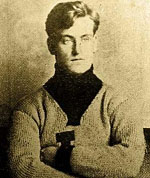
Doc Fenton

Michael Lally

"Big" Stovall
|
The SIAA committee didn't release its report until September 20.
Your committee, after carefully weighing all the evidence pro and con, unanimously reports its findings to be as follows:
1. That there has been during the past two years grave irregularities in athletics at L.S.U.
2. That Coach Wingard has been in most, if not all cases, responsible for these irregularities, and that he should therefore be disqualified for serving as coach or as athletic director in any institution belonging to the S.I.A.A.
3. That Martin F. Lally professionalized himself in Towanda, Pa., during the summer of 1908, and was therefore ineligible to play football on the L.S.U. team during the autumn following.
4. That Charles Ora Buser, a member of the L.S.U. football team of 1907, violated article 9, section 8 of the by-laws of the S.I.A.A. in playing under the assumed name of Chas. C. Bauer.
5. That the charges against the other members of the L.S.U. teams, while furnishing grounds for suspicion, have not been sustained by the evidence, and should therefore be dismissed.
6. That the irrregularities above referred to have existed without the knowledge, connivance or even suspicion of the L.S.U. authorities, and that said authorities are absolutely sincere in their belief in the innocence of Coach Wingard and the accused members of their various teams.
- Lally had accepted payment to play a baseball game in the summer of '08. He didn't even keep the money for the game but instead used it to pay a substitute to sing in his place at a picture show.
- The full SIAA refused to accept the committee's report at its annual meeting, and Lally was back on the team for '10.
- LSU dismissed Wingard September 24. He moved to the Carlisle Indian School in PA where he assisted Pop Warner.
- Joe Pritchard from Vanderbilt replaced Wingard as head man for the '09 football season.
The Daily State-Times editorialized about the entire situation.
... the dismissal of Coach E. R. Wingard and the suspension of M. F. Lally is, of course, a bitter disappointment to the friends of Louisiana State University and those who had, and still have, faith in the honest of her athletic system.
Those in Baton Rouge familiar with all the facts do not believe that essential justice was done the two men who suffer individually - yet it is generally admitted that there may be another side of the shield ...
Mr. Lally's work in L.S.U. has stamped him as one of the best type of college men - as far as the poles from the "professional ringer." Mr. Wingard, so far as the writer was able to ascertain, worked as hard for a "clean team" as for a "winning team."
Yet it must be admitted that the air was full of gossip; that the number of men on the team from a distance looked suspicious to outsiders, and when this is remembered, the S.I.A.A. committee may be understood to have taken the one technical offense of Mr. Lally as indicating what might have been a practice, and for the sake of clean sport, to have acted thereron.
One thing is sure.
L.S.U., while sore and sorry, is not going to be unsportsmanlike enough to follow Tulane's custom and quit the association. ...
|
CON
|


































